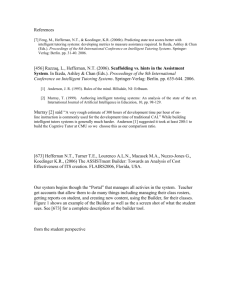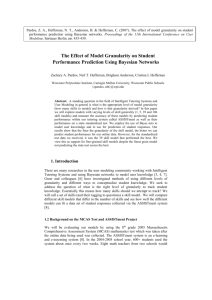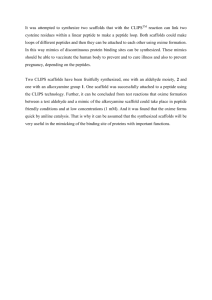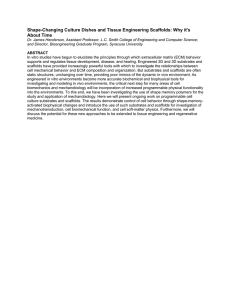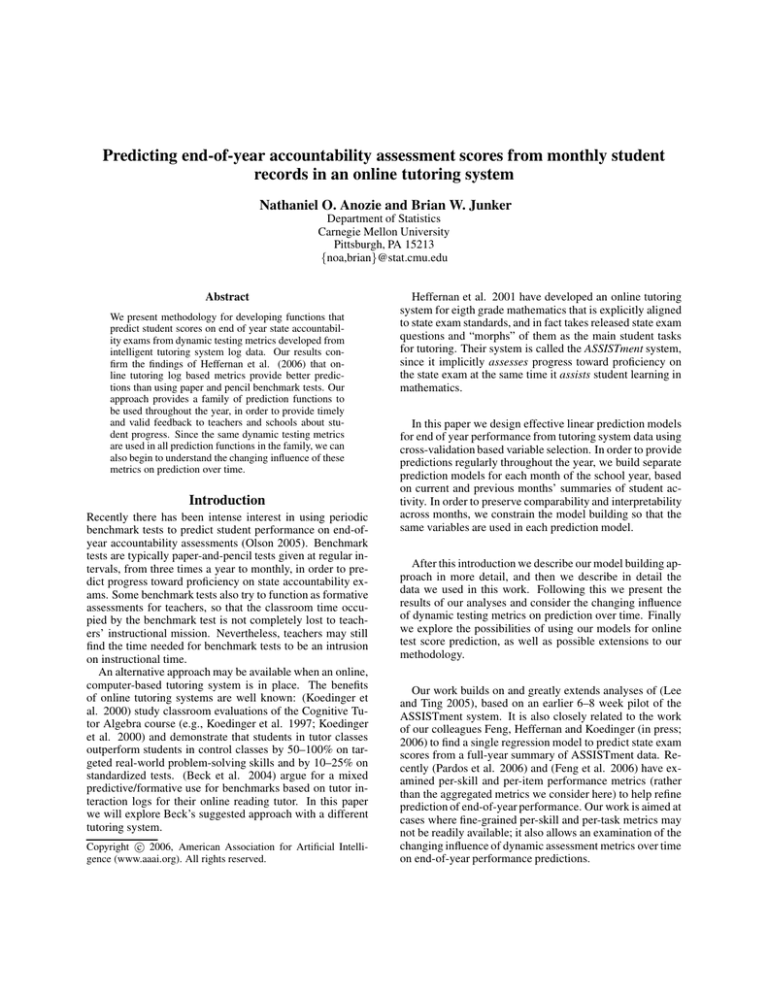
Predicting end-of-year accountability assessment scores from monthly student
records in an online tutoring system
Nathaniel O. Anozie and Brian W. Junker
Department of Statistics
Carnegie Mellon University
Pittsburgh, PA 15213
{noa,brian}@stat.cmu.edu
Abstract
We present methodology for developing functions that
predict student scores on end of year state accountability exams from dynamic testing metrics developed from
intelligent tutoring system log data. Our results confirm the findings of Heffernan et al. (2006) that online tutoring log based metrics provide better predictions than using paper and pencil benchmark tests. Our
approach provides a family of prediction functions to
be used throughout the year, in order to provide timely
and valid feedback to teachers and schools about student progress. Since the same dynamic testing metrics
are used in all prediction functions in the family, we can
also begin to understand the changing influence of these
metrics on prediction over time.
Introduction
Recently there has been intense interest in using periodic
benchmark tests to predict student performance on end-ofyear accountability assessments (Olson 2005). Benchmark
tests are typically paper-and-pencil tests given at regular intervals, from three times a year to monthly, in order to predict progress toward proficiency on state accountability exams. Some benchmark tests also try to function as formative
assessments for teachers, so that the classroom time occupied by the benchmark test is not completely lost to teachers’ instructional mission. Nevertheless, teachers may still
find the time needed for benchmark tests to be an intrusion
on instructional time.
An alternative approach may be available when an online,
computer-based tutoring system is in place. The benefits
of online tutoring systems are well known: (Koedinger et
al. 2000) study classroom evaluations of the Cognitive Tutor Algebra course (e.g., Koedinger et al. 1997; Koedinger
et al. 2000) and demonstrate that students in tutor classes
outperform students in control classes by 50–100% on targeted real-world problem-solving skills and by 10–25% on
standardized tests. (Beck et al. 2004) argue for a mixed
predictive/formative use for benchmarks based on tutor interaction logs for their online reading tutor. In this paper
we will explore Beck’s suggested approach with a different
tutoring system.
c 2006, American Association for Artificial IntelliCopyright gence (www.aaai.org). All rights reserved.
Heffernan et al. 2001 have developed an online tutoring
system for eigth grade mathematics that is explicitly aligned
to state exam standards, and in fact takes released state exam
questions and “morphs” of them as the main student tasks
for tutoring. Their system is called the ASSISTment system,
since it implicitly assesses progress toward proficiency on
the state exam at the same time it assists student learning in
mathematics.
In this paper we design effective linear prediction models
for end of year performance from tutoring system data using
cross-validation based variable selection. In order to provide
predictions regularly throughout the year, we build separate
prediction models for each month of the school year, based
on current and previous months’ summaries of student activity. In order to preserve comparability and interpretability
across months, we constrain the model building so that the
same variables are used in each prediction model.
After this introduction we describe our model building approach in more detail, and then we describe in detail the
data we used in this work. Following this we present the
results of our analyses and consider the changing influence
of dynamic testing metrics on prediction over time. Finally
we explore the possibilities of using our models for online
test score prediction, as well as possible extensions to our
methodology.
Our work builds on and greatly extends analyses of (Lee
and Ting 2005), based on an earlier 6–8 week pilot of the
ASSISTment system. It is also closely related to the work
of our colleagues Feng, Heffernan and Koedinger (in press;
2006) to find a single regression model to predict state exam
scores from a full-year summary of ASSISTment data. Recently (Pardos et al. 2006) and (Feng et al. 2006) have examined per-skill and per-item performance metrics (rather
than the aggregated metrics we consider here) to help refine
prediction of end-of-year performance. Our work is aimed at
cases where fine-grained per-skill and per-task metrics may
not be readily available; it also allows an examination of the
changing influence of dynamic assessment metrics over time
on end-of-year performance predictions.
Modeling
ASSISTment dynamic testing metrics
Eighth graders from two schools in the Worcester Public
School District used the ASSISTment system in the September thru July 2004-2005 school year. Four hundred “main
questions” or main items were available for students to practice with. These main items were mostly previous Massachusetts Comprehensive Assessment System (MCAS) 1
exam questions and prima facie equivalent versions (or
“morphs”) of them. Each main item was supplemented with
a set of “scaffold questions” intended to help students who
did not get the main item right on the first try. An ASSISTment is one main item together with its available “scaffold
questions”. In October students spent on average 27 minutes
in the system and answered approximately 11 main questions and 21 scaffold questions.
Thus not only can the system keep track of right and
wrong answers on first attempts at MCAS questions, it can
also differentiate between students who need more or less
help to get the right answers: students who ask for more
hints, who take longer before answering a question, etc.,
may be distinguished from students who ask for few hints
or need only a brief time to answer. These dynamic testing
metrics (cf. Campione et al. 1985) can be very predictive of
student achievement. The dynamic testing metrics we considered were constructed by examining the earlier work of
(Lee and Ting 2005) and Feng, Heffernan and Koedinger
(2006; in press), and by considering additional variables that
may be helpful in predicting MCAS scores (see Table 1).
In our approach we first construct monthly summaries of
these variables, for each month of the ASSISTment field
trial of 2004–2005. For each month, we build a linear model
predicting MCAS scores from that month’s summaries as
well as any previous month’s summaries. Variable selection for the models proceeds in two stages, first eliminating
variables that are highly redundant with other variables in
Table 1, and then selecting a final set of variables by minimizing cross-validation prediction error (Wasserman 2004,
pp. 218, 364). The final set of monthly prediction models
are constrained to use the same set of variables, in order to
facilitate comparison of the models across months.
Model building
Stage 1 In Stage 1 our goal is to eliminate variables that
are highly correlated with other variables in Table 1. Separately for each month, we begin with the full set of monthly
summaries and calculate variance inflation factors (VIF; see
Hamilton 1992, pp. 133, 135) for each variable. The variable with the highest VIF is eliminated, and VIF’s are recalculated. This backwards-selection procedure is iterated
until all VIF’s are less than 10 (this is equivalent to multipleR2 < 0.90 for predicting each remaining variable from the
others). For a variable to be considered in Stage 2, it must
be retained in all trial months.
1
http://www.doe.mass.edu/mcas
Stage 2 In Stage 2 we peform cross-validation-assisted
forward selection where we evaluate prediction error by 10fold cross validation (Wasserman 2004, pp. 220, 363; see
also Snee 1977), using the sum over all models of the mean
absolute deviation (MAD). This forward selection procedure
is not like standard forward selection in two ways. First,
we are evaluating variables for inclusion in seven prediction
models simultaneously: each variable is either included in
all models or it is excluded from all models. Second, each
variable actually appears seven times, summarizing the same
dynamic testing metric in each of the seven trial months, and
all current and past monthly summaries are considered in
each monthly prediction model.
Data: the 2004-2005 ASSISTment tutor trial
Of the 912 students that worked with the ASSISTment system at some time during the trial year, only 105 students had
complete data in each of the seven months October through
April.
We imputed students’ monthly summaries for months in
which they did not use the ASSISTment system by copying forward their summaries from the most recent month
in which they did use the system. Hence students considered must have worked with the ASSISTment system in
September and/or October 2004. We think this imputation
is a reasonable reflection of student performance because it
was rare to go back more than two months to retrieve data for
imputation: in March where the most number of imputations
were made, 868 of the 912 students used the ASSISTment
system. 50% of these March students needed no imputation, 23% needed pulling forward from February, and 14%
needed pulling forward from January, etc.
After imputation 697 students of the total 912 students
had complete data. 560 of these 697 students had usable
data for the variable selection procedure we described above
(they had MCAS scores and never had a completion time
of zero seconds on any main question or scaffold that they
answered). 15 of these 560 students had perfect main question scores and so required additional, logical, imputation
for percent correct on scaffolds (100%), time spent on incorrectly answered scaffolds (zero seconds), etc. 362 of these
560 students had complete pre- and post-tests, as described
by Feng et al. (2006), and some of our analysis focus on this
subset.
Results
Stage 1.
After running the Stage 1 backwards elimination procedure,
11 variables remained in the pool. These variables are listed
in bold in Table 1. The choices made by this procedure generally make sense; for example among variables measuring
quantity of questions completed, rate of question completion, and time spent on questions, at least one of these was
eliminated.
Nevertheless two variables that we felt might have an important interpretive contribution were also eliminated from
the variable pool: Percent correct on main questions (PctCorMain), and Number of hints requested plus number of in-
Table 1: Variables in bold face passed our Stage 1 collinearity check, and were considered for Stage 2 variable selection.
Italicized variables were also considered in Stage 2, because of their strong substantive interpretation; they did not substantially
increase collinearity when added to the variable pool for Stage 2.
Summary Per Month
Definition
P ctCorM ain
PctCorScaf
SecIncScaf
NumPmAllScaf
NumHintsIncMainPerMain
AttIncMain
SecCorScaf
NumPmAllMain
PctSecIncScaf
SecIncMain
MedSecIncMain
PctSecIncMain
N umHintsIncM ain
NumAllMain
NumAllScaff
NumCorMain
NumHintsAll
NumAttAll
NumSecAll
AttCorMain
AttCorScaf
AttIncScaf
SecCorMain
NumCorScaf
MedSecAllMain
NumIncMain
NumIncScaf
Percent of main questions correct
percent of scaffolds correct
Number of seconds on incorrect scaffolds
Number of complete scaffolds per minute
Hints plus incorrect main questions per ASSISTment
Number of attempts on incorrect main questions.
Number of seconds on correct scaffolds
Number of complete main questions per minute
Percent of time on scaffolds spent on incorrect scaffolds
Number of seconds on incorrect main questions.
Median number of seconds per incorrect main question
percent of time on main questions spent on incorrect main questions
Hints plus incorrect main questions
Number of complete main questions
Number of complete scaffolds
Number of correct main questions
Number of hints on main questions and scaffolds
Number of attempts
Number of seconds on main questions and scaffolds
Number of attempts on correct main questions
Number of attempts on correct scaffolds
Number of attempts on incorrect scaffolds
Number of seconds on correct main questions
Number of correct scaffolds
Median number of seconds per main question
Number of incorrect main questions
Number of incorrect scaffolds
correct main questions (NumHintsIncMain) These two variables were added back into the variable pool and VIF’s were
recomputed. They are listed in italics in Table 1. After their
re-introduction, none of the eleven previously selected variables had a max VIF larger than 10. Thus, all 13 bold-faced
and italicized variables in Table 1 were available for analysis
in Stage 2.
Stage 2.
Our main analysis was conducted on the full set of 560 students described in the data and subjects section, and the 13
bold-faced and italicized variables listed in Table 1. Variables were added one-at-a-time, according to maximum reduction in cross-validation MAD summed over all seven linear prediction models; when no further variable additions
reduced the MAD, the procedure ended.
Figure 1 shows this cross-validation based variable selection procedure, averaged over 100 cross-validation runs. On
each run random splits of the data were made. Variables
from Table 1 are listed across the bottom of the graph; the
number in parentheses following each variable is the number of runs (out of 100) for which the variable was selected
into the regression models. The solid line graphed in Figure 1 shows the average order of selection of each variable,
across the runs for which it was selected: an average order
of one indicates that the given ASSISTment metric, on average, was selected first into all seven models; two indicates
that the given ASSISTment metric, on average, was selected
Average Value October
(Most Used Month)
0.28
0.41
784.20
1.36
3.46
8.63
181.00
1.13
0.79
466.00
65.11
0.78
32.54
11.26
20.77
4.26
25.54
48.59
1613.00
4.25
8.23
27.48
181.40
8.42
56.90
7.00
12.35
second into all seven. Approximate Wald-style 95% confidence intervals for order of selection are also shown.
Figure 1 shows that percent correct variables: PctCorMain and Percent correct on scaffold questions (PctCorScaf), and a time efficiency variable: number of seconds spent on incorrectly answered scaffolds (SecIncScaf)
appeared as the first, second and third variable entered in
each of the 100 cross-validation runs. A second time efficiency variable number of scaffolds completed per minute
(NumPmAllScaff) and a help seeking variable number of
hints and incorrect main questions per number of main questions were entered fourth and fifth in about 78 of the 100
cross-validation runs.
In Figure 2 we show the results of a second crossvalidation experiment designed to explore how predictions
of the MCAS exam improve as more data is accumulated. In
this experiment, variables were added to each of the seven
regression models one at a time, in the order indicated in
Figure 1. 10-fold cross-validation MAD’s were calculated
after each variable was added. This procedure was also repeated 100 times, and the resulting MAD’s were averaged.
In Figure 2, the top most line represents the October
model. The first point on this line represents the average
10-fold cross-validation MAD, averaged over 100 crossvalidation replications, for a model containing only the October summary of PctCorMain. The second point on the
same line represents the average MAD, for a model containing only October summaries PctCorMain and PctCorScaf,
MAD
7.5
)
)
ai
n
ai
n
cM
ai
n
sI
n
cM
N
N
um
um
H
H
N
um
H
in
t
ec
In
Pc
tS
ai
n
cM
cM
cI
n
Se
cI
n
Se
M
ed
ai
n
cS
ca
f
ec
In
Pc
tS
Pm
um
in
t
N
Se
cC
or
Al
lM
Sc
af
ai
n
ai
n
cM
M
tIn
er
sI
n
At
Al
lS
ca
f
ai
nP
Pm
um
N
cM
Sc
af
or
cI
n
Se
Pc
tC
Pc
tC
or
M
ai
n
ai
n
cM
sI
n
cS
ca
f
(0
)
(0
ai
n
cM
ec
In
in
t
H
um
N
cM
cI
n
cI
n
Se
ed
M
Pc
tS
cM
ai
n
ai
n
(3
(0
)
)
)
(3
(9
cS
ca
f
ec
In
Se
um
Pc
tS
Pm
Al
lM
Sc
af
or
cC
N
Se
ai
n
(1
(3
6)
2)
8)
(7
ai
n
ai
n
cM
M
er
tIn
in
t
sI
n
At
)
5)
cM
um
Pm
ai
nP
Al
lS
ca
f
(9
00
(1
cS
ca
f
N
Se
or
Pc
tC
cI
n
Sc
af
(1
(1
00
00
)
)
6.0
2
6.5
7.0
MAD per student
8.0
8.5
12
8
6
4
Average order
10
HI 95% CI
AVG ORDER EST
LOW 95% CI
ai
n
M
or
Pc
tC
oct model
nov model
dec model
jan model
feb model
march model
april model
9.0
14
MAD Order of Varable selection
Variable ordering
Variable ordering
Figure 1: Average order of variable selection in stage 2. The
number in parenthesis indicates the number of trials the variable was selected. Each average order score is calculated
by averaging the order of inclusion in each of the indicated
number of trials. An order of 1 indicates the variable is entered first on average, a 2 indicates if the variable is entered
second on average.
and so forth: as more variables are added, the MAD goes
down. On the other hand, the first point on the second line in
Figure 2 represents the average MAD for a model containing October and November summaries of the PctCorMain
variable etc.
For our final prediction models we included all variables
until the last variable for which the April model’s average MAD score decreased. Thus, we consider all variables
added before and including this cutoff, they are: percents
correct on main items and on scaffold items, rates of completion for scaffold items, time spent on incorrectly answered
scaffold items and number of hints plus incorrect main questions per main question.
Comparison with Bench mark tests
Here we compare prediction of MCAS scores using the variables chosen in our variable selection procedure, with prediction using only the paper and pencil pre- and post-tests
described in (Feng et al. 2006), for the subset of 362 of the
full set of 560 students who also have these paper and pencil
test scores. For this analysis we did not use cross validation
to calculate mean absolute deviations; instead we calculated
training-sample MAD’s by producing model fits determined
by the subset of 362 students and appropriate ASSISTment
metrics or paper test variables. Residuals without cross validation should be lower than residuals using cross validation,
because with cross validation we are not using each students
data in each model fit.
Table 2 shows that predictions of the MCAS exam get better as we accumulate data, that is, we see that R2 adjusted
increases and MAD’s decrease with additional ASSISTment
Figure 2: Average MAD score produced per model. Each
point is calculated by averaging over 100 crossvalidation experiments. The order of variable entry is indicated on the
horizontal axis and was determined from the first 100 run
cross-validation experiment. See Figure 1.
metric monthly summaries. In addition we see that three
months of ASSISTment data (October through December)
produce models with better R2 adjusted and MAD than the
pretest only model; and four months’ data exceeded the predictive power of the pre-test and post-test together.
Coefficients
Table 3 gives coefficients of dynamic testing metrics for the
seven linear models. We see how the influence of various online system metrics on MCAS score prediction change over
time. As would be expected, percent correct on main questions and scaffold questions contribute positively to predict
MCAS score, each time their coefficients are significantly
different from zero in these models. In addition, number
Table 2: R2 adjusted, and (MAD) for 362 students who
have pre and post paper tests. Stage 2 models using top
five variables are shown below Pre-test and Post-test. These
variables are: PctCorMain, PctCorScaf, SecIncScaf, NumPmAllScaf, and NumHintsIncMainPerMain.
Model
Pretest
Pre-test & Post-test
October
Oct thru November
Oct thru December
Oct thru January
Oct thru February
Oct thru march
Oct thru April
R2 adjusted
MAD
0.523
0.557
0.368
0.474
0.527
0.568
0.578
0.577
0.637
6.690
6.440
7.737
7.069
6.585
6.151
6.013
5.978
5.462
% Error
(MAD/54)*100
12.388
11.925
14.328
13.090
12.195
11.392
11.135
11.070
10.115
Table 3: Coefficients of dynamic testing metrics for the seven linear models. Coefficients significantly different from zero at
the α = 0.05 level are in bold.
Model
Oct
Oct
Nov
Oct
Nov
Dec
Oct
Nov
Dec
Jan
Oct
Nov
Dec
Jan
Feb
Oct
Nov
Dec
Jan
Feb
March
Oct
Nov
Dec
Jan
Feb
March
April
PctCorMain
Coef
14.66
5.58
11.32
2.44
6.33
11.47
1.87
5.23
4.51
16.03
2.22
4.66
4.54
13.49
6.41
1.88
4.18
4.43
12.21
3.29
7.60
1.76
3.65
5.33
7.31
2.00
6.62
7.83
Se
2.63
2.73
2.68
2.69
2.72
2.66
2.56
2.60
2.71
2.54
2.57
2.60
2.69
2.69
2.46
2.56
2.59
2.68
2.72
2.66
2.70
2.43
2.45
2.54
2.66
2.53
2.65
1.95
PctCorScaf
Coef
19.37
11.92
12.05
8.67
7.89
12.36
6.50
7.39
6.71
8.81
6.14
7.09
6.09
8.50
1.41
6.15
6.03
6.39
7.70
-0.09
2.94
3.98
5.27
6.72
5.71
0.51
1.18
6.32
Se
2.59
2.70
2.45
2.65
2.50
2.37
2.54
2.38
2.47
2.12
2.54
2.38
2.46
2.27
2.03
2.53
2.38
2.47
2.30
2.27
2.43
2.42
2.25
2.35
2.20
2.16
2.40
1.70
SecIncScaf
*1000
Coef
Se
-1.22
0.74
-2.07
0.72
-1.04
0.52
-2.09
0.70
-1.66
0.58
1.09
0.61
-1.77
0.67
-1.63
0.56
1.00
0.60
0.01
0.59
-1.69
0.67
-1.40
0.58
1.05
0.60
-0.09
0.64
-0.59
0.81
-1.74
0.66
-1.32
0.59
1.03
0.59
0.15
0.65
-0.57
0.88
-0.30
0.69
-1.87
0.63
-0.88
0.56
0.89
0.57
-0.02
0.63
-0.80
0.84
-0.23
0.66
0.96
0.80
of scaffolds completed per minute and number of hints and
incorrect main questions per number of main questions contribute positively to MCAS score prediction: Thus, a higher
rate of completion of scaffold questions seems to be evidence of proficiency, rather than cheating or some other
gaming behavior. On the other hand, number of seconds
spent on incorrectly answered scaffold questions contributes
negatively in all of the cases in which its coefficients are
significantly different from zero. Both the ASSISTment
system, and teachers themselves, may wish to devote more
attention to students who are going slowly through scaffold questions; further analysis may be needed to determine
whether these students spend more time per scaffold, or encounter more scaffolds, than their peers.
Some trends in the regression coefficients can be understood from Table 3. We see that the most recent summaries
of percent correct on main questions seem to be most important for predicting MCAS scores, in contrast to percent
correct on scaffolds where early summaries appear to be significant. In addition we see that time spent on incorrectly answered scaffolds seems to matter more in the early months.
The last two variables: number of completed scaffolds per
minute and number hints and incorrect main questions per
main question seem to matter in later months.
Two other aspects of Table 3 are worth noting. First,
even when the coefficients are not significant, the magnitudes of the coefficient for the two percent correct scores
NumPmAllScaf
Coef
1.34
0.63
0.55
0.52
0.17
1.41
0.47
0.08
1.33
0.22
0.50
0.19
1.24
-0.18
0.85
0.59
0.31
1.00
-0.21
0.58
0.59
0.62
0.08
1.02
-0.09
0.43
0.21
1.41
Se
0.54
0.55
0.42
0.54
0.44
0.55
0.52
0.42
0.55
0.44
0.52
0.43
0.55
0.48
0.42
0.52
0.43
0.55
0.48
0.50
0.49
0.49
0.41
0.52
0.46
0.48
0.48
0.47
NumHintsInc
-MainPerMain
Coef
Se
-0.13
0.28
-0.03
0.28
0.03
0.28
-0.07
0.27
-0.18
0.30
0.88
0.34
-0.09
0.26
-0.19
0.29
0.44
0.35
0.99
0.35
-0.06
0.26
-0.21
0.29
0.43
0.35
0.89
0.38
0.30
0.32
-0.04
0.26
-0.26
0.29
0.41
0.35
0.84
0.38
0.21
0.36
0.32
0.28
0.06
0.25
-0.23
0.28
0.56
0.34
0.39
0.37
0.27
0.35
0.48
0.29
-0.15
0.19
Intercept
Coef
14.01
12.35
–
4.71
–
–
0.44
–
–
–
-1.92
–
–
–
–
-3.15
–
–
–
–
–
-4.72
–
–
–
–
–
–
Se
14.66
5.58
–
2.44
–
–
1.87
–
–
–
2.22
–
–
–
–
1.88
–
–
–
–
–
1.76
–
–
–
–
–
–
tends to be higher for the later months’ summaries in each
model (this seems especially true for main questions, less
so for scaffolds). Thus the linear models are to some extent “downweighting” old information about each student’s
performance, in making MCAS predictions. Second, and
an exception to the first observation, coefficients for January
summaries tend to be large and/or significant in any model
in which they appear. We are not sure what makes January
special in these analyses.
Conclusion
In this paper we have presented a methodology for developing functions that predict student scores on end of
year state accountability exams from dynamic testing metrics developed from intelligent tutoring system log data.
Although collecting data through the ASSISTment system
takes longer than collecting paper and pencil benchmark
testing data, our analysis agreed with that of (Feng et al.
2006) in that predictions by the ASSISTment system out
performed predictions by a bench mark test. The first of
these variables is a direct ASSISTment system analogue to
paper and pencil test scores. The other four variables are
uniquely available in the ASSISTment environment. It is especially interesting to see that efficiency in completing scaffold questions appears in all but two of the variables considered; such data is not easy to collect except in the context of
a computer-based tutoring and testing system.
In this paper we begin to understand the changing influence of these metrics on prediction over time. Understanding how these metrics relate to learning as time changes is
important in developing models that could potentially inform schools about state standards. For example the Proficiency Index 2 for Massachussets schools can be easily derived from these models.
We also repeated the analyses described in this paper using mean squared error (MSE) and classification error as
our cross-validation criterion and we saw simlar results. For
example we used the five achievement levels used by Massachussets to group student performance on the MCAS, and
defined classification as the total number of students missclassified in any of the five groups divided by the number of
students in all five groups. We found that the five variables
selected by the MAD-based procedures described in this paper, with one addition, seconds on correct scaffolds, were
also optimal when using achievement level classification error as the stage 2 criterion.
In future work, we plan to compare our algorithm to other
online learning algorithms that can model data changes over
time. It would be interesting to see if the learning curves
would behave simlarly with these algorithms and how well
they could do at predicting end-of-year assessment scores
from monthly tutoring records. In particular we will consider comparing the performance of this method to the two
models based on item-response theory of (Ayers and Junker
2006).
Acknowledgements
This research was made possible by the US Dept of Education, Institute of Education Science, “Effective Mathematics
Education Research” program grant #R305K03140, the Office of Naval Research grant #N00014-03-1-0221, NSF CAREER award to Neil Heffernan, and the Spencer Foundation. All the opinions in this article are those of the authors,
and not those of any of the funders.
This work would not have been possible without the assistance of the 2004-2005 WPI/CMU ASSISTment Team
including Kenneth Koedinger, Elizabeth Ayers, Andrea
Knight, Meghan Myers, Carolyn Rose all at Carnegie
Mellon, Steven Ritter at Carnegie Learning, Neil Heffernan, Mingyu Feng, Tom Livak, Abraao Lourenco, Michael
Macasek, Goss Nuzzo-Jones, Kai Rasmussen, Leena Razzaq, Terrence Turner, Ruta Upalekar, and Jason Walonoski
all at WPI.
References
Ayers, E.; and Junker, B. W. 2006. Do skills combine additively
to predict task difficulty in eigth-grade mathematics? Accepted,
American Association for Artificial Intelligence Workshop on
Educational Data Mining (AAAI-06), July 17, 2006, Boston,
MA.
Beck, J. E.; Jia, P.; and Mostow, J. 2004. Automatically assessing oral reading fluency in a computer tutor that listens. Technology, Instruction, Cognition and Learning 2: 61-81.
2
http://www.doe.mass.edu/sda/ayp/about.html?section=3
Campione, J. C.; Brown, A. L.; and Bryant, N. R. 1985. Human abilities: An information-processing approach. Individual
differences in learning and memory:103-126.
Feng, M.; Heffernan, N. T.; and Koedinger, K. R. 2006. Predicting State Test Scores Better with Intelligent Tutoring Systems:
Developing Metrics to Measure Assistance Required. Accepted,
2006 Intelligent Tutoring Systems Conference, Taipei, Taiwan.
Feng, M.; Heffernan, N. T.; and Koedinger, K. R. in press. Addressing the Testing Challenge with a Web-Based E-Assessment
System that Tutors as it Assesses. The 15th International World
Wide Web Conference, Edinburgh, Scotland.
Feng, M.; Heffernan, N. T.; Mani, M.; and Heffernan, C. L.
2006. Does using finer-grained skill models lead to better predictions of state test scores?. Submitted to the International Conference on Intelligent Tutoring Systems (ITS 2006): Education
Data Mining Workshop, Jhongli, Taiwan.
Hamilton, L. 1992. Regression With Graphics: A Second Course
in Applied Statistics. Belmont, California.: Duxbury Press,
Heffernan, N.T., Koedinger, K.R., Junker, B.W. (2001). Using
Web-Based Cognitive Assessment Systems for Predicting Student Performance on State Exams. Technical Report, Institute
of Educational Statistics: US Dept. of Edcuation. Dept. of
Computer Science, Worcester Polytechnic Institute Univ.
Koedinger, K. R.; Anderson, J. R.; Hadley, W. H.; and Mark, M.
A. 1997. Intelligent tutoring goes to school in the big city. International Journal of Artificial Intelligence in Education 8:30-43.
Koedinger, K. R.; Corbett, A. T.; Ritter, S.; and Shapiro, L. J.
2000. Carnegie Learning’s Cognitive Tutor: Summary research
results. White Paper. Technical Report, Carnegie Learning,
Pittsburgh, PA.
Lee, C.; Ting, D. 2005. Predicting MCAS Scores from the
ASSISTment System. Technical Report, Dept. of Statistics,
Carnegie Mellon Univ.
Olson, L. 2005. State Test Programs Mushroom as NCLB Mandate Kicks In. Education Week, Nov. 30: 10-14.
Pardos, Z. A.; Heffernan, N. T.; Anderson, B.; and Heffernan,
C. L. 2006. Using fine-grained skill models to fit student performance with Bayesian networks. Submitted to the International
Conference on Intelligent Tutoring Systems (ITS 2006): Education Data Mining Workshop, Jhongli, Taiwan.
Snee, R. D. 1977. Validation of regression models: methods and
examples. Technometrics 19: 415-428.
Shao, J. 1993. Linear model selection by cross-validation. Journal of the American Statistical Association 88: 486-494.
Wasserman, L. (2004). All of Statistics: A Concise Course in
Statistical Inference. New York, NY.: Springer-Verlag.

